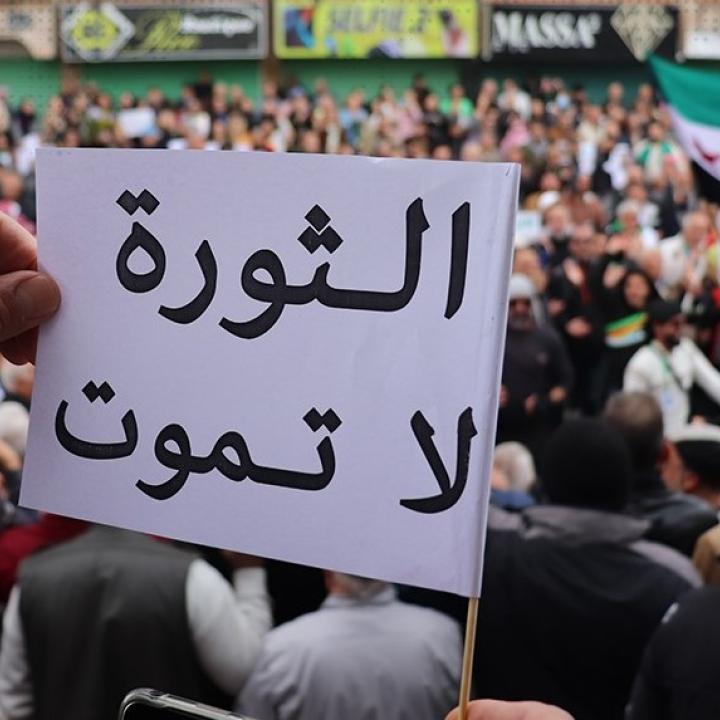
- Policy Analysis
- Fikra Forum
Suwayda Protests Continue Despite Growing Pressure

The protest movement’s ability to weather pressures from the Assad regime has allowed Suwayda to remain an impressive display of solidarity, tenacity, and bravery, alongside a willingness after over a decade of conflict in Syria to still demand a better future.
On May 12, Syrian president Bashar al-Assad appointed retired General Akram Ali Mohammed as governor of Suwayda. Known for his brutal crackdown on early protests in Aleppo in 2011, General Mohammed’s appointment is likely a thinly veiled threat by the Assad regime to the current protest movement in the southwestern province. His arrival coincides with the deployment of armed vehicles and heavy weaponry to the outskirts of Suwayda, notably near Khalkhala airport and several state security bases. Despite this ominous development, the people of Suwayda—who have been engaged in protest in support of political change in Syria since last August—remain steadfast in their nonviolent campaign.
For nearly ten months, protesters have consistently gathered in Suwayda city’s Karama Square and throughout the towns and villages of Suwayda province. Demonstrators are demanding that the international community hold Assad accountable for his crimes, release detainees, uncover the fate of those forcibly disappeared, and implement UN Resolution 2254. This movement is remarkable not only for its size and duration, but for its nonviolent nature. Even after state security forces killed Jawad Al-Barouki (52) during a demonstration in February, protesters and residents remained committed to peaceful demonstrations, refusing to resort to violence—a tactic the Syrian regime had presumably hoped to exploit in order to paint the movement as an armed rebellion.
The regime's attempts to infiltrate the peaceful movement have also failed, despite efforts to sow discord through agents and portray the movement as a Druze separatist movement. Protesters reject any narrative of sectarian division, and the Druze community’s spiritual leader, Sheikh al-Hajiri, has advised against displaying the five-colored Druze flag or the Syrian opposition flag as a way of preventing internal fracturing along ethnic, religious, or political lines.
A local activist, when asked about the persistence of the protests despite challenges, replied that: "Although Karama Square hosts diverse agendas reflecting the political affiliations of residents, it accommodates all who demand justice and freedom. Despite differing political and social views, protesters unanimously agree on the need to remove Assad's regime and its destructive influence on the country. They take pride in thwarting attempts to create divisions in Karama Square, dealing with incidents like armed factions entering protests with remarkable awareness, guided by Sheikh Al-Hajri's insistence on non-violence and efforts to heal rifts peacefully.”
Attempts by the regime to clear the square of protesters—who reflect a wide range of ages and include both men and women—have failed, and so far, the regime has stopped short at employing direct armed suppression. For a regime infamous for its brutality against its own citizens, such hesitance to use force may seem bizarre. However, Assad has likely been advised by his close ally Russia to avoid a direct crackdown, as this would spark international outrage. Citizens of Suwayda note similarities with strategies used in neighboring Daraa in the past, where Russia oversaw reconciliation programs and disarmament that paved the way for an eventual regime takeover.
Despite the regime’s more “cautious” approach to the Suwayda protests, recent incidents have escalated tensions. In addition to General Mohammed’s appointment and the encirclement of Suwayda city by the military, security forces in Latakia–traditionally a stalwart of regime support–arrested student Dani Obeid for "undermining state authority" after he posted support for Suwayda's peaceful movement on social media. In response to his arrest, local groups in Suwayda detained senior army and police officers, including Brigadier General Manar Mahmoud, demanding Obeid's release. The regime eventually released Obeid, who immediately joined the protesters in Karama Square, reaffirming their unchanged demands.
The protest movement’s ability to weather these pressures has allowed Suwayda to remain an impressive display of solidarity, tenacity, and bravery, alongside a willingness after over a decade of conflict in Syria to still demand a better future. A local human rights activist explains her view of what keeps the people of Suwayda on the streets: "It's the hope of implementing UN Resolution 2245, the belief in holding war criminals accountable, particularly the Assad regime, and the understanding that Syria's stability is crucial for regional peace.”
The activist noted that the involvement of local leadership has also been key: “The support from respected religious figures like Sheikhs Al-Hajri and Al-Hanawi lends credibility and strengthens popular will, linking this movement to the national struggle and the historical respect the Druze community commands for their contributions to the Syrian people's fight for a better life. The positive resonance of this movement across Syria and among refugees offers new hope for resolving the complex socio-political crisis since the current regime's inception."
The protests in Suwayda will continue as long as they are not suppressed by violence from the Syrian regime because they draw their momentum from popular Syrian support in several areas. For many Syrians both abroad and at home, these protests have become a beacon of hope for salvation. This has become all the more so the case given the solidarity with a new peaceful movement against Hayat Tahrir al-Sham (HTS) leader Al-Jolani in the Idlib region, which has developed in Syria over the past several months and currently ongoing.
Peaceful demonstrators in northern Syria have supported the Suwayda uprising since its inception, considering it an extension of the Syrian revolution that ignited in 2011. Likewise, after the recent protests began against HTS and Al-Jolani in the northern Syrian region, demonstrators in the Karama Square in Suwayda carried banners supporting this peaceful movement against Al-Jolani and HTS, affirming that Syrians from every part of Syria stand together against oppression and tyranny as long as they are able to do so.
Image source: السويداء الثورة و الحراك السلمي


